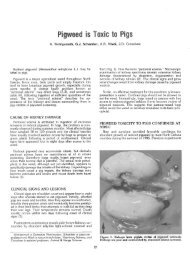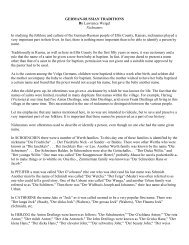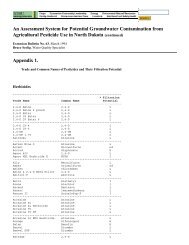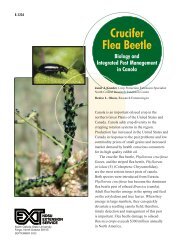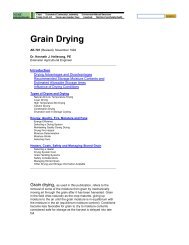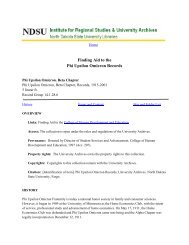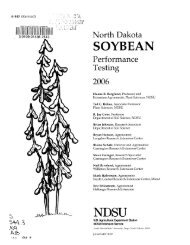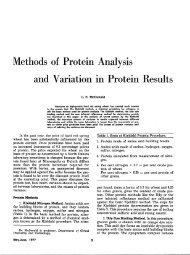germans from russia in fort collins, 1900-2000 - Libraries
germans from russia in fort collins, 1900-2000 - Libraries
germans from russia in fort collins, 1900-2000 - Libraries
You also want an ePaper? Increase the reach of your titles
YUMPU automatically turns print PDFs into web optimized ePapers that Google loves.
WORK RENDERS LIFE SWEET: GERMANS FROM RUSSIA IN FORT COLLINS<br />
In late 1903, another German-Russian<br />
settlement, northeast of Buck<strong>in</strong>gham,<br />
evolved <strong>from</strong> an assemblage of migrant<br />
worker shacks on the Peter Anderson farm.<br />
An avid civic booster, Anderson was the lead<strong>in</strong>g<br />
champion of the sugar factory <strong>in</strong> Fort<br />
Coll<strong>in</strong>s. He purchased the quarter section east<br />
of Fort Coll<strong>in</strong>s <strong>in</strong> 1865 and later <strong>in</strong>creased the<br />
farm to 330 acres. The Larimer County pioneer<br />
eventually amassed a small <strong>fort</strong>une runn<strong>in</strong>g<br />
cattle and feed<strong>in</strong>g lambs. He was vice<br />
president of the First National Bank of Fort<br />
Coll<strong>in</strong>s, president of the Well<strong>in</strong>gton Bank,<br />
and owned a harness shop and hardware<br />
store. He was also one of the first farmers <strong>in</strong><br />
Larimer County to plant sugar beets and use<br />
German-Russian labor. 37<br />
Early <strong>in</strong> their existence, the German-<br />
Russian neighborhoods acquired a wide variety<br />
of names <strong>from</strong> the Englische across the<br />
Poudre. In a footnote to his history of<br />
Germans <strong>from</strong> Russia <strong>in</strong> Fort Coll<strong>in</strong>s, Mark<br />
Spier tried to make sense of the different<br />
names:<br />
Buck<strong>in</strong>gham was known to<br />
Americans and Germans alike as “the<br />
Jungles” and birth records carry that<br />
name for many born there.<br />
Andersonville is referred to as “Saratov”<br />
by the Germans and <strong>in</strong> contemporary<br />
newspapers as “Russianville,” “New<br />
Russia,” “Russian Quarters,” “Little<br />
Russia,” and “Russiatown.”<br />
Buck<strong>in</strong>gham and Andersonville are<br />
referred to as “St. Petersburg” but<br />
Buck<strong>in</strong>gham receives the name most<br />
often. 38<br />
Native-born Americans often used the<br />
term the “Jungles” to describe the cacophony<br />
and eng<strong>in</strong>eered disorder of dangerous<br />
mach<strong>in</strong>es, pollut<strong>in</strong>g chimneys, and foreignborn<br />
laborers common to major <strong>in</strong>dustrial<br />
sites. This mean<strong>in</strong>g of the word entered popular<br />
parlance as Progressive-era reformers<br />
targeted factory ghettos, achiev<strong>in</strong>g <strong>in</strong>famy <strong>in</strong><br />
Upton S<strong>in</strong>clair’s 1906 novel, The Jungle, an<br />
exposé of Chicago’s meatpack<strong>in</strong>g <strong>in</strong>dustry. 39<br />
As the “Jungles” <strong>in</strong>creased <strong>in</strong> population,<br />
so too did they <strong>in</strong>crease <strong>in</strong> notoriety.<br />
Buck<strong>in</strong>gham and Andersonville drew the<br />
scorn and <strong>in</strong>trigue of Fort Coll<strong>in</strong>s residents <strong>in</strong><br />
the same way slums and tenements attracted<br />
the attention of the eastern, urban upper and<br />
middle classes. Newspapers <strong>from</strong> the period<br />
are littered with sordid, tantaliz<strong>in</strong>g blurbs<br />
about liquor violations, “disorderly houses,”<br />
shoot<strong>in</strong>gs, and stabb<strong>in</strong>gs. In report<strong>in</strong>g the creation<br />
of Andersonville, the editor of the<br />
Weekly Courier could not resist a tongue-<strong>in</strong>cheek<br />
jab at the new German-Russian settlement:<br />
“It is rumored that two saloons will<br />
soon be opened at Andersonville, the new<br />
suburb. In that event a trolley l<strong>in</strong>e <strong>from</strong> this<br />
city to that po<strong>in</strong>t would be a pay<strong>in</strong>g <strong>in</strong>vestment.”<br />
40<br />
Yet while outsiders attempted to degrade<br />
Germans <strong>from</strong> Russia and their neighborhoods,<br />
residents with<strong>in</strong> the settlements struggled<br />
to improve their lot. Keenly aware of the<br />
suspicious eyes of the Englische across the<br />
Poudre, Buck<strong>in</strong>gham and Andersonville residents<br />
ma<strong>in</strong>ta<strong>in</strong>ed tidy, safe neighborhoods. In<br />
1904, most of the houses had lace curta<strong>in</strong>s at<br />
the w<strong>in</strong>dows and pleasant gardens <strong>in</strong> the<br />
backyard. 41 By the beg<strong>in</strong>n<strong>in</strong>g of that year,<br />
residents <strong>in</strong> Buck<strong>in</strong>gham began clamor<strong>in</strong>g for<br />
a town of their own. At the end of January,<br />
Figure 4.<br />
This view of East L<strong>in</strong>coln Avenue<br />
reveals the size and shape of most<br />
dwell<strong>in</strong>gs <strong>in</strong> Buck<strong>in</strong>gham. (Photo by<br />
the author.)<br />
SWCA Environmental Consultants Page 10



